Action for Safe and Legal Abortion
Old Palace Yard, London, Sat 29 Sep 2012
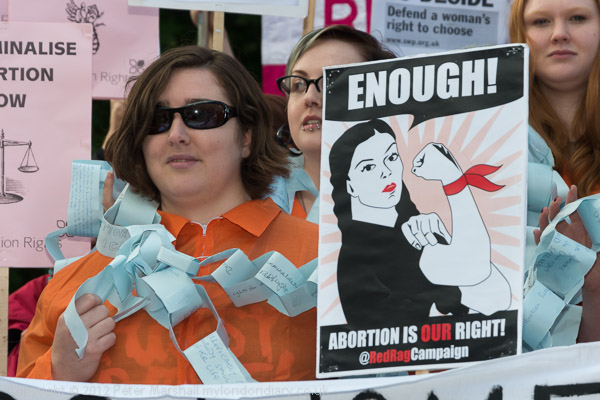
Chains from Northern Ireland and a poster 'Enough! - Abortion is our Right'
more pictures
Almost a hundred people, mainly women, came to Old Palace Yard opposite the Houses of Parliament to protest for women's reproductive rights in a protest organised by Abortion Rights.
Women's rights to abortion are coming under increasing attack from militant right wing 'Christian' groups who are following the lead of their US counterparts and harassing women as they go into abortion clinics. One of the protesters had a placard 'Go forth and harass women outside abortion clinics - Said Jesus NEVER', pointing to the essentially anti-Christian nature of anti-abortion protests such as this.
One male counter-protester came to hold up a large poster in front of their protest, making claims that the protesters were in favour of killing young humans, of dismembering them, burning their bodies and throwing them out with rubbish or flushing them down the toilet. He was well known to most of the protesters, having appeared making similar claims at previous pro-choice protests, and they were soon surrounding him and arguing with him, and holding up their placards in front and around him.
There were a number of speakers, including a woman from an organisation that helps women from Northern Ireland where abortion is still illegal - and could lead to truly draconian penalities, even life imprisonment - to come to the UK and have abortions. Coming here is difficult - the women could be arrested for doing so - and also expensive, as women resident in Northern Ireland cannot get a NHS abortion but have to use private clinics.
Several women read women's accounts from the past and present of the problems they had suffered from under laws against abortion and the medical complications of illegal abortions, and there was one truly harrowing account of the attempts the family of one young woman had made to provoke a miscarriage, including various assaults and of the consequences of a horrendous attempt at illegal abortion.
The only politician who spoke was the newly elected leader of the Green Party, Natalie Bennett, who gave her party's wholehearted support to the protest.
The event ended with a group of orange-clad 'prisoners' with balls chained
to their ankles carrying a long paper-chain, each link carrying a hand-written
message from a woman at a conference in Northern Ireland calling for the right
of women there to have abortions.
more pictures
Parliament Square Peace Campaign Continues
Parliament Square, London. Sat 29 Sep 2012

Barbara Tucker and the Peace Campaign are still there
despite harassment by police and authorities
more pictures
Despite various laws enacted to enable the removal of the Parliament Square Peace Campaign and frequent harassment by police, the campaign continues its 24/7 vigil, today 4137 days long, the last 257 days of which have been without shelter.
Brian Haw began his campaign on the pavement in front of Parliament Square facing the Houses of Parliament on 2nd June 2001. Clauses were added to the Serious Organised Crime and Police Act 2005 (SOCPA) intended to end his protest, but careless drafting led to their failure. A second attempt was made in the Police Reform and Social Responsibility Act 2011 (PRSR), sections 141-150, which prohibits the use of any tent or other structure "designed, or adapted, (solely or mainly) for the purpose of facilitating sleeping or staying in a place for any period" or the keeping or use in Parliament Square of any "sleeping equipment" - defined as "sleeping bag, mattress or other similar item designed, or adapted, (solely or mainly) for the purpose of facilitating sleeping in a place".
Sadly, Haw died in hospital in Germany on 18 June 2011 of lung cancer, but his protest has been continued by others, notably Babs Tucker who joined him in his protest in 2006. Police raided the site on the evening of 16th January 2012 when a dozen or so police vans, police cars, 2 police lorries and an ambulance arrived around 7.30pm and had removed the tents, sleeping bags and other equipment including megaphones in what the protesters claim was an illegal seizure, and at 3 am the following morning arrested Tucker, releasing her around 15 hours later after the magistrates court had set a trial date. By early March this year she had been arrested 44 times and jailed twice for her protests since 2006.
Since then there have been various other raids, usually in the middle of the night when few supporters are around in what appears to be a deliberate campaign of harassment and sleep deprivation. Among other items, umbrellas have been seized, although their sole or main purpose is surely to keep off the rain rather than to facilitate sleeping.
On Thursday the Parliament Square Peace Campaign went to the High Court to apply for an injunction to prevent the police from seizing any further property without securing a conviction in any earlier cases against them under the PRSR. On Friday night the police were back and again seizing material; the protesters repeatedly asked for a written instruction and were refused it, and the video they made appears to show the Inspector concerned assaulting Ms Tucker.
Also on Thursday Ms Tucker was sent an e-mail on behalf of the Attorney General, threatening an action under the Contempt of Court Act 1981 for publishing audio recordings of the proceedings at the West London Magistrates Court and Royal Courts of Justice on the wwwbrianhaw.tv web site and You Tube, and demanding their removal within 72 hours.
This afternoon there were half a dozen protesters on site continuing the
Parliament Square Peace Campaign protest. A large poster on the pavement points
out that Article 20 of the UN Declaration of Human Rights states "Everyone
has the right to freedom of peaceful assembly and association."
and comments "but not at the centre of DEMOCRACY where even seeking
shelter is against the law."
more pictures
Hornsea & East Yorkshire
Fri-Mon 21-24 Sep 2012
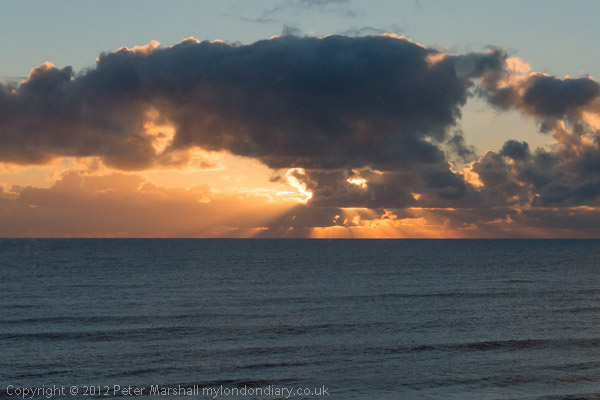
I hardly had to get out of bed to take this picture
on Saturday morning - through my hotel room window
more pictures
We spent a long weekend visiting friends and attending a family event in East Yorkshire, where I took a lot of pictures which are mainly of interest to those who were there and won't appear here. But we did have some time to see a little of the area, in particular with a walk along the top of the cliffs from Withernsea to Aldbrough on the Saturday. There used to be a public footpath along the coast, but almost all of that has now disappeared under the sea as the mud cliffs get eroded. It's a process that has been going on for years, and the current average rates of loss on the stretch we walked varies from around 1.5 to 3 metres a year.
We had an OS map that was roughly 30 years old, so the cliff edge along which the path used to go was now between 50 and a hundred metres inland, and most of those actual marked rights of way had long disappeared. There were clear areas of fairly recent falls, some still standing with unharvested wheat a yard or two lower than the remaininf firm land, and at times we walked over some rather ominous cracks in the earth. It wasn't a walk I would have attempted in poor weather, and involved quite a few minor detours to keep a reasonably safe distance from the edge. Having done it I would recommend others not to try parts of the route.
Ten years ago, I cycled down many of the minor roads and tracks that once led to houses and farms long gone, with barriers or signs now warning of the end of the road at a falling cliff edge. One or two had definitely changed now, and there were some new signs. Also new from earlier visits were some of the works associated with the Aldbrough gas storage facility, currently being expanded with some work on the cliff top and beach. We had to make a slight detour and some tracks slightly inland have simply disappeared. In other places where the path would have gone over some deep drainage ditches we had to scramble up and down banks and sometimes detour inland to an easier spot to tackle them. This is a pretty remote area in some ways, and at times we would have had a long walk back had we been unable to get past the obstacles, and I was pleased when we got back onto a road that took us to Aldbrough, with a couple of shops and pubs and a bus stop. It was then a long wait for the bus (there aren't many) and it was good to be able to sit down with a pint or two.
There are also some pictures from Hornsea itself, where we were staying on the seafront, as well as a few taken from the several buses we travelled on and in Tickton, where again we had quite a while to wait for the last bus around 6pm.
We arrived back shortly before it started to rain, with a strong wind off
the sea buffeting the front of the hotel and giving an annoyingly audible
vibration to its sattelite dish. It was still raining when we woke up on Monday,
Hornsea was wet and cold and we were not sorry to get on the bus to start
our journey home.
more pictures
Women Protest Against Rape
Downing St, London. Tue 19 Sep 2012
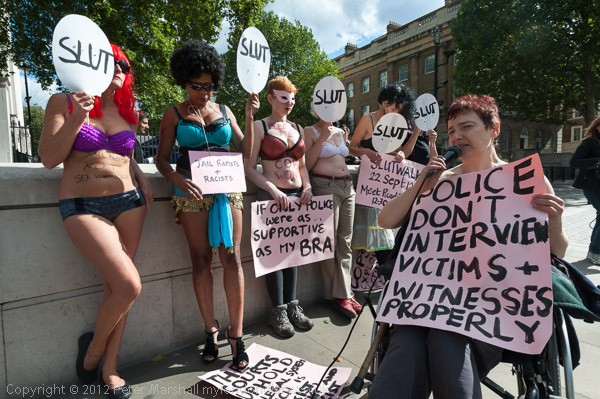
Women protest in their underwear calling for justice
for rape survivors
more pictures
Women stood opposite Downing St in their underwear to demand justice for rape survivors, whose claims are often dismissed or downgraded by the police who often blame the victim not the rapist. Less than 1 in 7 reports of rape end in a conviction.
Fifteen or so women, including rape victims, sex workers, a disablement activist in a wheelchair and a pensioner, stripped to their underwear for the protest, holding up placards with the word SLUT and posters against the current failure by the law, police and courts to treat rape seriously. Most too had slogans painted on their bodies, and they sang and chanted and spoke in protest.
This protest ahead of Saturday's SlutWalk march from Piccadilly to a rally in Trafalgar Square, organised by Women Against Rape and supported by other groups including the English Collective of Prostitutes, highlighted many of the issues that result in such a low conviction rate for rape, with only seven in every hundred women who go to the police for help seeing their attackers convicted. Not only that but police often accuse the woment who report rape of lying, and they risk prosecution and possible imprisonment.
Women of colour feel they are discriminated against by police, and asylum seekers and refugees are under threat of deportation if they make a complaint. Sex workers are sometimes told that rape is a consequence of their job that they should expect, and police often go out of their way to enforce laws which put them at risk, rather than doing anything to protect them.
Among the slogans that the women chanted was the well-known "Whatever we wear and wherever we go, yes means yes and no means no". Women who are raped are not the guilty party, and efforts to tranfer guilt to them hit out at ideas of equality. They result from a culture of treating women as objects, as subjects for male desire, rather than people. The idea that rape is caused by how women dress or that how they dress somehow excuses rape is abhorrent. Most rape - outside of war zones - is by men who are known to their victim and has nothing to do with what they are wearing, but reflects the unequal relationship between men and women which it as the base of our society.
One woman who spoke at the event said that she had become a campaigner because her daughter had gone to the police and reported she had been raped, and the police had charged her instead of making false accusations and she had been sentenced to jail.
Another woman had the message on her body "I didn't report - he was my boyfriend." A study in 2009 reported that although 14,000 rapes were reported to the police in 2008, the actual number taking place is much higher. Estimates vary from 70 to 95% of rapes go unreported.
Many women who do report rape rapidly withdraw the complaints, often because of what seems unsympathetic treatment by police. Other cases are dropped because police or CPS feel the witness 'lacks credibility'. Most cases that succeed do so because the defendant pleads guilty, and relatively few from succesful trials.
Statistics about rape are contentious, and the headline 'Only 7 out of every 100 reported rapists are convicted. The other 93 go free' appears to be only partially correct. According to The Guardian, around 13% of reported rapes results in a conviction, of which around half are for "lesser offences such as sexual assault and others" and only 6.5% for rape. Guardian Readers Editor Chris Elliot suggests that figures that more usefully demonstrate that there is a problem over rape convictions are "the percentage of (reported) crimes for which someone is charged, summonsed, and receives a caution or other formal sanction", whch for violence against the person was 44.5%, while for rape was only 29.9%. While not so eye-catching it is still a large discrepancy.
The protesters urged everyone to take part in the SlutWalk protest
on the following Saturday.
more pictures
Weybridge Walk
Weybridge, Surrey. Mon 18 Sep 2012
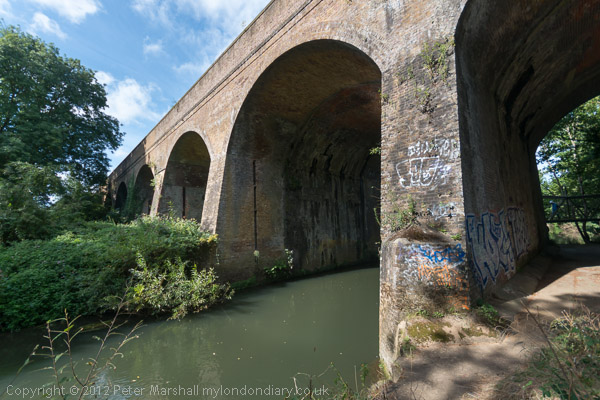
The bridge carries the main line from Waterloo to the
southwest over the River Wey
more pictures
I don't know Weybridge well. Its a part of real Surrey amd used to have a good shop for Leica cameras. Feeling plush a few years back, just having got a largish salary cheque, I cycled across the Thames and bought a Leica M8 there. Two weeks later I got the sack (it was a job writing about photography, and I got the push for being interested in photography and not being American) and Wey cameras went bust.
The only bit of Weybridge I really know well is the station. We used to have a useful train service to Woking and Guildford, but Brooklands College got together with Surrey and persuaded the railway company to run it to Weybridge instead. Handy for students at the college, but nobody else wants to go to Weybridge, let alone have to cross the bridge and wait for ages for a connection from there to Woking.
The branch line that runs from Addlestone to Weybridge does have some interesting
views, an old mill on the Wey navigation, flooded gravel pits, a sewage farm
and the Wey itself, and this walk I was taken on with my family members followed
much of its route before turning back along the navigation to Weybridge, where
we had a decent no-nonsense home-cooked pub meal (getting rare in these days
of pseud's gastro) at the British Volunteer.
more pictures
Soho Drag Queens Race for Charity
Soho, London. Sun 17 Sep 2012
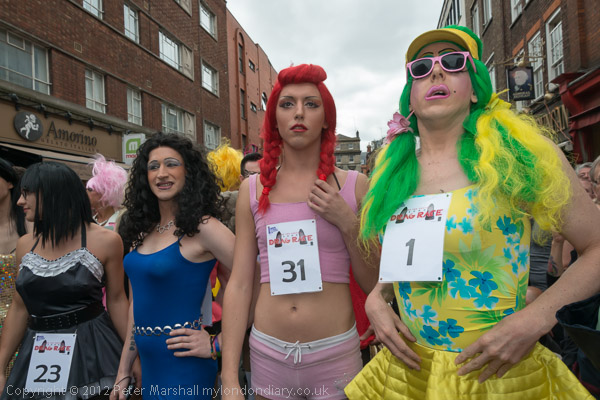
Drag queens line up for the start of the 1km race
more pictures
A large crowd watched around 50 drag queens in high heels race a gruelling 1km around the back streets of Soho in the second annual Soho Drag Race, raising funds for the charity for young, homeless LGBT people, the Albert Kennedy Trust.
The Albert Kennedy Trust works with 16-25 year old lesbian, gay, bisexual and trans young people who are homeless or live in a hostile environment. The Soho race is sponsored and hosted by the well-known Admiral Duncan pub in Old Compton St and a temporary stage was erected outside it for the event, which was hosted by entertainer Candy Slag In Drag and Coronation Street star Charlie Condou. As well as the race, there were a number of cabaret acts performing on the stage, including Baga Chipz, Vicki Vivacious, Mrs Moore, Bette Rinse, Rose Garden, Mandy Gap and Tanya Hyde, though I left before most of them had appeared. Among those expected to take part in the race were well-known Drag Queens including Stephanie Von Clitz and Frankie Fantastique.
Candy Slag in Drag has a reputation as one of the sharpest tongues around, and she certainly lived up to her reputation as she introduced the race and commented on some of those taking part, including Mrs Moore who entertained the crowd before the start of the race.
The race was hotly contested by at least some of the competitors, although others took it rather easily, and some found the going too tough; one pulled off her high pink heels after the first 200 metres and finished the race barefoot. As well as wearing heels (or running as a three-legged team), those taking part have to raise at least £50 for the AKT, the cost of keeping one of the 500 young people supported by the trust off the streets for a weekend.
After the race, while we were waiting for Charlie Condou to arrive and present the prizes, Rose Garden, from Northern Ireland, gave a spell-binding performance, aided at one point by one of the contestants who had come dressed in a Pussy Riot based outfit and joined in on stage with air guitar.
The winner was Latvian-born Olegs Pushkus (aka Barbara), with Murilo Sanchez in second place, and Miss Mince Meat third, and there was also a prize for the person raising the most sponsorship - won by a runner from Maidenhead, who I think had personally raised around the total amount made by last year's race - the first in what is intended to be an annual event. This year the race attracted more entrants, a bigger crowd and made much more for a worthwhile charity.
March & Rally for a Secular Europe
Westminster, London. Sat 15 Sep 2012
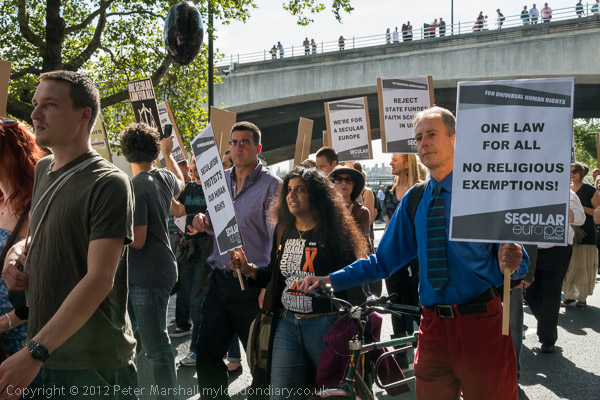
Peter Tatchell was among the marchers
more pictures
Around 250 humanists, atheists and others marched through London to a rally in protest against the privileged status of religion, calling for a truly secular society with freedom of religion, conscience and speech with equal rights for all.
The marchers gathered at Storey's Gate, next to Methodist Central Hall and across the road from Westminster Abbey, both in their different ways reminders of the links between the state and states and religion. They had come to protest against the privileged status of religious organisations in countries around the world, but particularly in Europe, and to call for a secular Europe with complete separation between church and state and with no special status on grounds of religion, one law for all without exemptions.
The marchers set off behind a banner reading 'For Universal Human Rights' and chanting slogans including '2,4,6,8, Separate church and state' and of course 'What do we want? A Secular Europe. When do we want it? Now', as well as stating that Women's rights (and Gay Rights, Children's Rights etc) are Human Rights. But perhaps the most popular was one directed in particular against the Catholic Church, 'Keep your rosaries Off my ovaries."
It was a fairly short march, followed by a lengthy rally on the street in Surrey Place which started with some Monty Python songs from the London Humanist Choir before a number of speeches. One of the highlights was Peter Tatchell, who like other speakers stressed that everyone in our society should be equal under the law and there should be no exceptions on any grounds such as religion. He went on to make the point that many people of faith also support both equality and the separation of religion and state, and that "for every bigot there are also people of faith who are with us."
Another powerful contribution was from Sue Cox of Survivors Voice,
reminding us not just of sexual abuse of children by priests, but also of
the continuing failure of the Catholic Church to deal with this, as well as
the sinister power that that church still wields in countries including Italy.
more pictures
Thousands March to Save Hospitals
Southall, London. Sat 15 Sep 2012
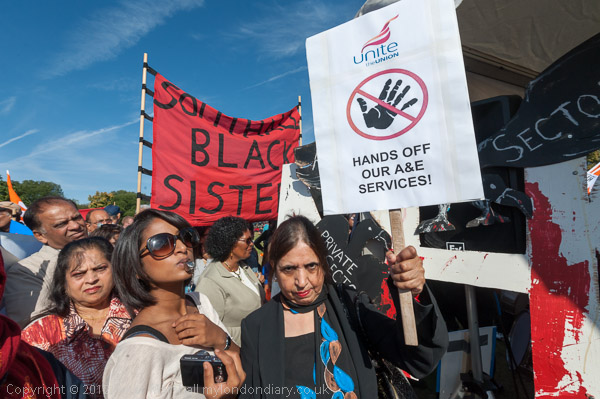
Listening to speakers before the march from Southall Park
more pictures
Almost 2000 marchers met at Southall Park to march to a rally in Ealing against the closure of A&E and other departments at Ealing, Central Middlesex, Charing Cross and Hammersmith hospitals. Another march was going to the rally from Acton.
The proposals to close Accident and Emergency services at four of the nine hospitals in North West London have provoked fury among local residents and united politicians of all parties in Ealing, and the London Borough Council gave its backing to the march and rally organised by the Save Our Hospitals campaign and backed by many organisations including trade unions and religious groups. Ealing council leader Julian Bell said:
"If these plans go ahead they will leave thousands of people without local access to essential services including A&Es, intensive care, maternity and paediatric units, while those with chronic conditions will have to travel further for regular treatment."
"We want to show NHS bosses that it is not acceptable to put financial considerations before people and this march and rally is a great opportunity for residents to come together to demonstrate their outrage at these plans."
Under the proposals, Ealing Hospital, on a large site with good road and public transport links on the Uxbridge Road, would lose nine of the 11 major types of service currently provided on-site, including the A&E, becoming a 'local hospital', as would Charing Cross. Central Middlesex Hospital would lose its already daytime only A&E unit and its intensive care unit, while Hammersmith Hospital would become only a specialist unit.
There were a little over a thousand people at Southall Park when the proceedings got under way with a number of local people involved with the NHS or with the organisation of the event gave short speeches about the effects these changes would have. Many spoke with the benefit of years of experience working for the NHS. Speakers pointed out how vital many community services were and that they needed to be close to where people lived - not long and often difficult journeys by public transport away. And it was pointed out that lives often depended on getting people treatment within minutes of accidents, so reducing the number of A&E units was bound to lead to more deaths.
The plans would keep open A&E units at five major hospitals, Chelsea and Westminster, St Mary's Paddington, Northwick Park, West Middlesex and Hillingdon - all fairly long journeys from Southall or Ealing.
There were many local politicians clamouring to speak, but fortunately they were told that they would have their chance later at the rally or the march would never have started. Two local Labour MPs were on the march, Steve Pound and Virendra Sharma, who was allowed to make a short speech.
After an hour or so in the park, the numbers had swelled considerably, and it took some time for all of the marchers to leave through a narrow gate and the march to form up on the street outside, before making its way along the Uxbridge Road where I left it. There were expected to be more than 5000 at the rally on Ealing Common, with another march making its way there from Acton Park.
Another protest was taking place today against these changes not far away
in Harlesden, with a march to a rally at Central Middlesex Hospital. Hammersmith
& Fulham Council have also opposed the plans, and a protest will be held
there next weekend. The public consultation over them comes to an end in October
and a decision is expected in early 2013.
more pictures
Cleaners at Société Générale Again
Tower Hill, London. Fri 14 Sep 2012
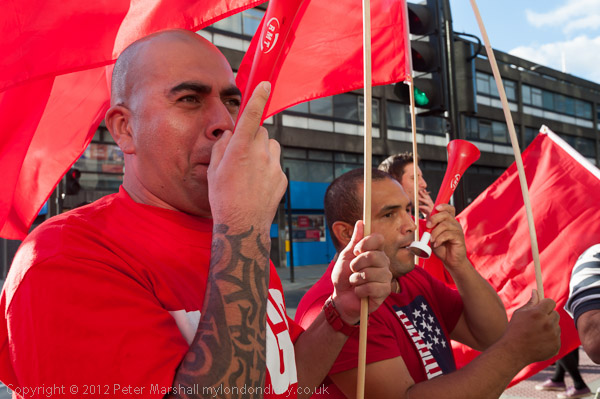
Cleaners keep up their action against the French bank
more pictures
Cleaners at Société Générale kept up the protest at the offices opposite the Tower of London after the bank and its contractor decided to slash working hours for the cleaners.
The cleaners were finally awarded the London Living Wage of £8.30 per-hour on 3rd September 2012. But the majority of cleaners were working from Sunday to Thursday from 9:00 pm to 5:00 am, eight hours per day. Societe Generale and their contractor Initial Facilieties have cut the cleaners working hours by 50% from 24th September. Now the cleaners are expected to do all the work previously done in eight hours in four.
The cleaners and their union the IWGB have been protesting regularly outside
the bank. They have received support from members of RMT, PCS, UNISON, NUT,
UCU and other workers and students. Many cleaners have been suspended for
being involved in the protests.
more pictures
Action For London Met Students
London Metropolitan Univ, Holloway Rd, London. Fri 14 Sept 2012
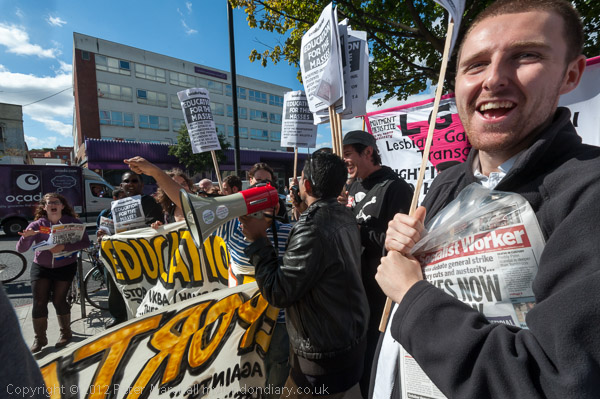
Students chant their support
more pictures
Demonstrations at London Met and universities around the UK called for London Met to be allowed to continue courses for overseas students and demanded that the 2600 students be allowed to finish their courses.
The decision to revoke the status of London Met will cause great hardship for the many hard-working students who have invested large amounts of money in a British education. Relatively few will be able to find suitable alternative courses in the UK, and many will either have to abandon their education here or prolong their studies by repeating years elsewhere.
It is unfair on the students involved, but will also impact on other students and teaching staff as the withdrawal of their funds will lead to course closures and redundancies. Economically it is insane, as it will severely damage one of our more valuable industries earning from overseas, and will cost the UK billions of pounds at a time of austerity.
Protests were taking place today at universities and colleges across the UK. Over a hundred students and supporters, including many overseas postgraduate students, came to the London Met's Holloway Road campus where a rally was being held. They called for and end the the UK Border Agency's unfair and racist persecution of London Met, and for Home Secretary Theresa May to resign.
Local MP Jeremy Corbyn pointed to the insanity of the policy, which will seriously damage not only the individuals concerned, but cost billions and threaten the future of one of the UK's most successful and profitable industries - Higher Education, which currently brings in billions of pounds each year and also has great long-term positive effects on British exports.
Several postgraduate overseas students spoke about the sever personal and financial impact the decision to stop their London Met courses were having. One said that his younger brother and sister who would have come to study in the UK were now planning to go to university in Canada.
There were several speakers from the staff of London Met, one who stated that the record keeping there was no worse than at other universities. London Met appears to have been picked on because of its record of success with students who it had given a second chance, particularly those from disadvantaged backgrounds in the UK who would not have been accepted by most other universities. London Met actually has more black students than all of the 24 leading universities in the Russell Group combined, and is seen as a threat to elitist views on education. A feature in this weeks Times Higher Education Supplement described it as "the most politically significant university in the country" and the action by the Borders Agency is seen as a politically and racially motivated assault.
London Met is taking the decision to the courts and their case is expected
to be heard next week. Speakers called for people to demonstrate their support
outside the court and for there to be further large demonstrations when students
return to universities around the country at the start of October. There was
also a call for practical support for overseas students in need of accommodation
and should any attempts be made to deport them. The protest more or less came
to an end when one of the overseas students led a chorus of 'Solidarity Forever...'
Many of the hundred or so had drifted away back to work at the end of their
lunch break and I too left.
more pictures
Grow Heathrow Open Day
Sipson, London. Sat 8 Sep 2012
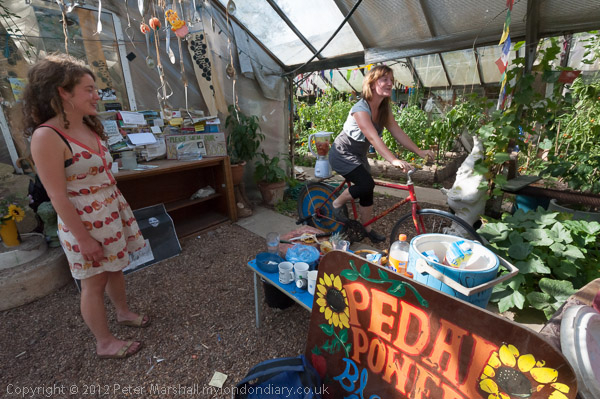
Pedal power blending a smoothie in one of the reclaimed greenhouses
more pictures
Transition Heathrow who have transformed a derelict market garden site close to Heathrow Airport since March 2010 with their Grow Heathrow project held a successful open day.
When Transition Heathrow moved onto the former Berkeley Nursery site at the start of March 2010 the site was a local eyesore and dumping ground. They had come particularly to fight against the plans for a third runway at Heathrow, which would destroy the site and the whole village of Sipson, but immediately realised the potential of the site to create a productive alternative home that would become a creative hub for the area.
They started by clearing much of the rubbish from the site - and got the local council to come and take away 30 tons of it which they had gathered together for them. But much of the material that was on the site they saw as a resource, and have recycled it with great ingenuity. The site is a very extensive one, and much remains uncleared, still covered by brambles, nettles, bushes and trees as a green wilderness close to the concrete of the airport and its motorway spur. Some of the residents have built their own small temporary homes in this area, while others still live in tents.
The site is now under renewed threat from the third runway plans, so development by the owners of the site remains unlikely. They have taken Transition Heathrow to court and won, but the occupiers in July were granted leave to appeal on human rights grounds, with Judge Karen Walden-Smith describing the project as "much loved and well used" by the local community.
The site welcomes visitors on any day within its opening hours, but there was a special welcome and programme of events this Saturday. Among the visitors was local MP John McDonnell, a firm supporter of the project who is quoted on their web site:
"This inspirational project has not only dramatically improved this derelict site but it has lifted the morale of the whole local community in the campaign against the third runway and in planning a sustainable future for our area. We cannot lose this inititiave and I will do all I can to enable it to continue."
Regular events take place every week involving those on the site and local residents, including bicycle workshops, art workshops and gardening. I saw some impressive examples of bikes produced on the site from recycled parts, and vegetables that made those in my own garden a few miles away look rather pathetic. There was plenty of evidence of the art work all around the site and in my pictures.
Grow Heathrow is really an impressive project, and shows what can be done.
I was impressed by the sawdust pile heating water and the wood burning shower
(with the water coming out just a little on the hot side) as well as the kitchen
and the food. It was a pleasant afternoon and I enjoyed being shown around
the site by one of the residents, as well as being able to roam as I pleased
in the more public areas of the site. But although it seemed to be a very
pleasant place to live on a warm summer day, I think it might be rather a
harsh existence in winter.
more pictures
Ghanaian Methodists Celebrate 10 Years
Westminster Cathedral, London. Sat 8 Sep 2012
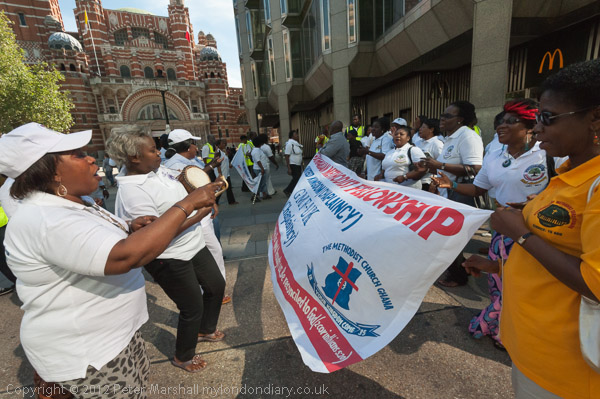
Women dance in front of their banner in the Cathedral Plaza
more pictures
Celebrations of 10 years of the Ghanaian Methodist Fellowship UK and its
16 churches end in a thanksgiving service this weekend. The day before they
went to Westminster Catholic Cathedral and then danced away towards Methodist
Central Hall.
more pictures
Day of Action Against Workfare
Camden & Brixton, London. Sat 8 Sep 2012
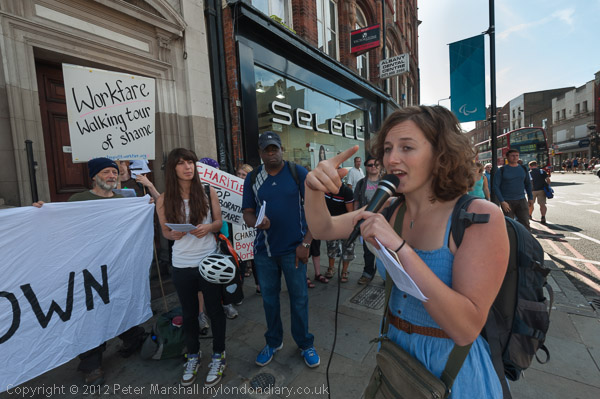
Time to go and protest outside some of the shops using
unpaid labour
more pictures
Boycott Workfare held a UK day of action targetted against charities and shops that take part in the government scheme of forced unpaid work which treats the unemployed as criminals. They also celebrated companies and charities that have withdrawn.
People receiving benefits who refuse to take part in 'voluntary' unpaid work schemes or whose participation is judged unsatisfactory face the loss of benefit. Government targest for such sanctions have results in the number of people involved increasing by a factor of 3 between 2009 and 2011, and there are now over half a million under these sanctions.
Boycott Workfare point out that the four week Mandatory Work Activity scheme is the equivalent of a medium level community service order - such as might be given to someone found guilty of assualt or drunken driving. While the maximum community sentence that a judge can hand out is for 300 hours, under some workfare schemes claimants are being forced to work without pay for 780 hours.
The sanctions against those whose work is - often for trivial reasons - judged not to come up to standard have led to bullying by many managers, even in some well-respected charities. There are also people who have been forced to give up voluntary work they were doing in order to take part in these workfare schemes.
One of those on the protest in Camden who came to the microphone made clear his own experiences of forced 'work experience', which over two years has not led to him getting an actual job. Work experience could with proper safeguards be useful to the unemployed, but there are no such safeguards in the government schemes, in fact very much the opposite.
Instead of the companies taking part taking on people who have worked for them on workfare, there is no incentive for them to do so, as they can get another set of unpaid labour. Workfare actually puts existing employed staff at risk - they can find themselves out of a job, replaced by unpaid labour, and many are also losing out financially as overtime can be reduced with free labour available to do the work.
In Camden Town, a group of around 25 people held a running series of protests against various shops and charities making use of unpaid labour, including Boots, Argos, Scope, Cancer Research UK and British Heart Foundation. Outside one of the charities, speakers made it clear that it wasn't those working in the stores as volunteers or paid staff that the protest was aimed at.
There are people on work programme placements in every one of the 700 British Heart Foundation shops, some mandatory, some voluntary. She had talked to eight people in the Brixton store on placements who told her they were there because "there is no choice". It was work for nothing or lose their benefits. Several there told her that they had qualifications and had worked for years, and were in no need of 'work experience' - just of jobs. She talked to a group of men working there, and one of them turned indicating the man working next to him and said "No offence, I'm unemployed and he's a criminal" and they were getting the same treatment. A black woman working for nothing there commented "It's absolutely slave labour - absolutely - it's the 21st century. They took me out of slavery and put me back in slavery."
The protest was still continuing as I left to go to Brixton, with more visits to shops and charities using unpaid workers planned before the end of the protest.
In Brixton a slightly smaller group was holding a banner and handing out leaflets on the busy pavement across the road from the Underground outside Poundland who have a number of unpaid staff at this and other branches. Most of those walking past took the leaflets and many stopped to express their disgust at the scheme which penalises those out of work. I briefly went inside the shop were a couple of protesters had gone to hand out leaflets, and a number of the workers clearly sympathised with the protest - and perhaps were there as unpaid workers. I talked briefly to one of the shoppers after she had been given a leaflet, and she was appalled at what she had learnt - so much so that she put the goods she was buying back, and asked me what we could do about it. I suggested that perhaps she might e-mail Poundland and tell them what she thought, and later when I went outside she was talking to the protesters outside.
As the organisers of the Camden 'Walk of Shame Against Workfare'
were keen to point out, the protests have already had some effect, persuading
groups including Burger King, Oxfam, Waterstones, Shelter, 99p Stores, Pizza
Hut and Sainsbury's to pull out from the scheme. Others including Age UK,
Boots and Savers don't quite seem sure what their policy is but have been
forced to rethink following the protests.
more pictures
Justice for Cleaners at Société Générale
Tower Hill, London. Thu 6 Sep 2012
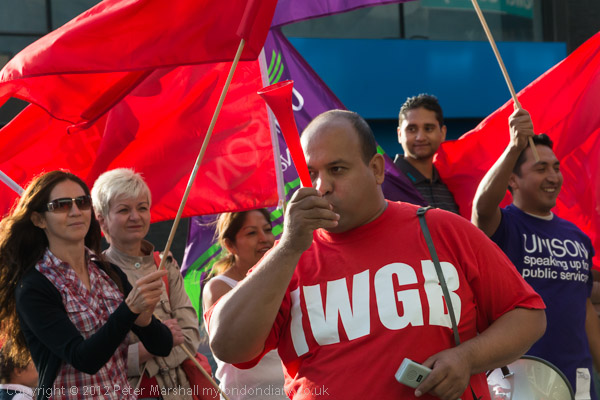 Alberto
Durango and other protesters outside the bank
Alberto
Durango and other protesters outside the bank
more pictures
Cleaners at Société Générale protested at the offices opposite the Tower of London after the bank and its contractor Initial Facilities went back on promises to suspend cuts in working hours and pay the London Living wage, and sacked a worker.
The protest was called by the IWGB, the Industrial Workers of Great Britain, recently constituted when the IWW London Regional Committee decided to re-launch as the Industrial Workers of the Great Britain, reviving the name of am industrial union originally formed in 1909 and disbanded around 1924. The cleaners were the largest and most active group of the IWW in London, and their vigorous campaigning has had considerable success in getting the London Living wage and better conditions for cleaners, most recently at John Lewis.
I had turned up at Société Générale on 29th August to find a small group of cleaners outside who had called off their protest following a last-minute assurance that the planned cuts in hours had been suspended, and that the London Living Wage would be introduced from 3rd September.
However the IWGB has since been informed that the cuts will be going ahead in a few weeks time, and have yet to get any confirmation that the London Living Wage is actually to be paid. The dispute has been exacerbated by the sacking of one young worker under what the IWGB describe as "the most questionable of circumstances" and they are demanding his immediate reinstatement.
Société Générale had again contacted the workers shortly before the today's protest saying that they would sort the matter out, but given what had happened previously the IWGB were not willing to call the protest off. But perhaps today's protest will lead to them coming to an agreement which they will keep.
The IWW Britain and Ireland Regional Administration in August reacted to
the formation of the IWGB by suspending Chris Ford and Alberto Durango from
their positions within the Union with immediate effect pending further investigation.
But today's protest suggests that the IWGB does not need the support of the
worldwide IWW union.
more pictures
Don't Deport London Met Students
Home Office, Westminster. Wed 5 Sep 2012
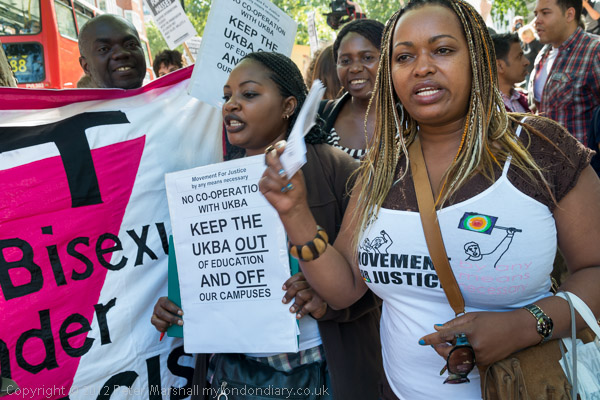
Overseas and home students protested outside the Home Office
more pictures
A protest at the Home Office called for international students at London Met University to be allowed to complete their studies and not face deportation after having invested heavily in getting a degree in the UK. Some then marched to Downing St.
Around 400 crowded into a pen outside the Home Office to call for a rethink over the decision to remove the licence for the university and end the courses for students who had paid their fees, attended their classes and had got good results. It is totally unfair to penalise the hard-working students for what appear at worst to be administrative errors by London Met, and the failure of some who had enrolled to attend classes.
Not only is it a great injustice for the many hard-working students involved, some of whom spoke at the event, but it also will involve a great financial loss. with the UK and higher education here losing billions over the years as many overseas students will decide to pursue their education in countries where they will not face arbitrary termination of their courses. The action by the Borders Agency amounts to burning money that the country desperately needs. Not only to the students educated here bring in currency directly in fees and their living costs, but while here they learn to use many British methods an products which they will go on to use and recommend over the length of their careers when they return to their home countries.
The protest was called by London Met UCU and London Met UNISON, and well as many students and staff from London Met the rally was also supported by many others, including a wide range of organisations across education, the Joint Council for the Welfare of Immigrants (JCWI) and London Region Unison. Among the many speakers, including international students, students leaders, staff and union leaders from London Met were North Islington MP Jeremy Corbyn and Habib Rahman of JCWI.
One of the overseas students held up a letter showing her good attendance record and asked she should be sent home - it helped to drive home the point of how unfair and immoral this decision is. Many of those from London Met voiced the opinion that their university had been singled out because of its strong committment to supporting students from a wide range of backgrounds and increasing access to university-level courses. The UKBA is also widely seen as a racist organisation, and may well have been stung into taking this decisive and ill-judged decision by the many criticisms that have recently emerged of its failures to carry out its job efficiently.
During the rally the call made for a walkout by students across the country in support of the London Met students next week at Friday lunchtime was repeated, and at Downing St there was widespread support among the crowd their for the idea that in London this should take the form of a march to London Met in solidarity.
At the end of the rally a letter was handed to an official who came out from the Home Office to receive it. Many of those present had then to leave to go back to work, but around two hundred decided to continue the protest with an impromptu march to Downing St. Police stopped them after a few hundred yards, and after some negotiation decided to facilitate the march along an agreed route to the pen opposite Downing St.
It took a little time for police to get into position and hold the traffic,
which was already very congested in Parliament Square, but eventually the
march made its way to the pen. There was a short token sit-down on Whitehall,
but the protesters soon decided to get up and go to the pen, where they continued
noisily to call for the threats of deportation to be lifted and students on
courses to be allowed to complete them. The protest was continuing as I left.
more pictures
Waltham Forest Defeats the EDL
Walthamstow, London. Sat 1 Sep 2012
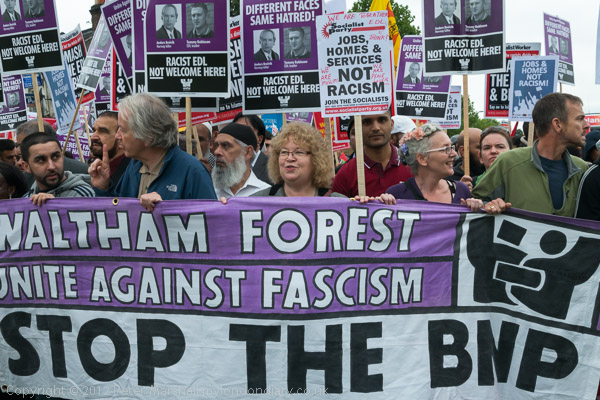
And the united people of Waltham Forest stopped the
EDL who suffered a humiliating defeat
more pictures
Several thousand people from all Walthamstow's communities came as 'We are Waltham Forest' to oppose the EDL march in Walthamstow. Police surrounded and escorted the several hundred EDL, diverting them around back streets to their meeting place.
The 'We are Waltham Forest' campaing has involved many of Walthamstow's community and faith organisations. Church of Enlgand Area Dean Steven Saxby spoke at the large rally in Walthamstow's main square between Walthamstow Central station and the market, as did Imam Yazdani from the Muslim Community - and 14 mosques in the borough had lent their support to the campaign against those who want to bring hate to the borough. Also speaking at the rally were the local MP, Stella Creasy, Green MEP for London Jean Lambert, North London GLA member Jennette Arnold, disability activist Ruth Bashall, Mark Campbell, UCU Chair at London Metropolitan University and Weymann Bennett, UAF and several others including one of the local organisers of the campaign. As well as the speeches there were also performances by local groups of drummers and singers.
It was a campaign that brought together a wide cross section of the community, not just the political left and members of UAF, and one that as we marched along Hoe Street brought people out from virtually every shop and building, many waving and cheering in support. Although there was angry chanting against the EDL who were called racists and fascists (and at the end a few sticks and stones were actually thrown at the EDL), it was overall a very friendly event, with people from all backgrounds and all ages mixing.
From the rally, there was a march the short distance to Forest Road, on the planned route for the EDL. Hundreds of people sat down on the street there blocking it, and the others stood around.
I walked down towards Blackhorse Road station where the EDL march was started, meeting it on its way. From a distance it could have been mistaken for a police march, with probably more officers around it than there were marchers - the police were taking few chances. As I took pictures a number of the EDL shouted abuse; others put their hands over their faces, and one rushed towards me, putting his hand over my lens before police pushed him back. It was hard to get good pictures because there were so many police around the march, though as I continued to receive threats and insults I was pleased that the police were there.
The marchers stopped at intervals to abuse some of those watching, a few had banners or shouted at the march in disapproval, but mostly were just abused because they were Muslim or black. They did find one supporter in Walthamstow, an elderly man who came out of his house to greet them, but he seemed to be the only one. Clearly here the silent majority they claim to represent was overwhelmingly against them.
It was clear that the march would not be able to continue on the planned route along Forest Road, but the protest against it was not successful in stopping it as police diverted the route down some back streets. On the corner as they march turned off Forest Rd there were a few scuffles though most of those I saw were between the EDL and EDL stewards and police. Several times here and as the march went across Chingford Rd, the stewards dragged other protesters away from the police and photographers at the side of the road, managing to keep the protest more or less in order.
The EDL march stopped in Farnan Avenue at the side of the Civic Centre site, and I went around the the frontage on Forest Rd, where a small group of EDL, including their leaders Tommy Robinson and Kevin Carroll had a public address system on the verge. There were barriers around it, and then an empty roadway with police keeping back protesters. I went to photograph Robinson, but was stopped by an EDL steward who insisted I was a UAF photographer and called over a police officer who insisted despite my showing my press card to him that I left the area. I unhitched a barrier and went to the other side.
Although the organisers of 'We Are Waltham Forest' had asked that the protest remain a peaceful one, by this time some of the protesters were getting worked up, and a few sticks and other objects were begining to be thrown towards the EDL. A small brick landed a few yards from Robinson, and was picked up by him and handed to a police officer as evidence. I moved to one side to avoid being hit if more objects were thrown. But by this time most of the counter-protesters had gone, and I decided that there were unlikely to be further developments. When I left around 3.30pm the EDL marchers were still surrounded by police and held in the side road.
Police later told them it was impossible for their rally to go ahead. They
were kept kettled by the police for hours for their protection. When the Met
found that the RMT were unwilling to let them onto trains they arrested the
lot of them taking them in vans to various police stations where they were
released, mostly with nowhere to go in the early hours of Sunday morning.
The small group of leaders who had not been on the march had left the area
long before while the march was still kettled.
more pictures
top of page
All pictures on this section of the site are Copyright © Peter Marshall 2012; to buy prints or for permission to reproduce pictures or to comment on this site, or for any other questions, contact me.

